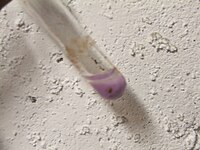Cobalt hydroxide
 |
|
 cobalt(II) hydroxide
|
|
| Names | |
|---|---|
|
IUPAC name
Cobalt(II) hydroxide
|
|
| Other names
Cobaltous hydroxide, cobalt hydroxide, β-cobalt(II) hydroxide
|
|
| Identifiers | |
|
3D model (JSmol)
|
|
| ChemSpider | |
| ECHA InfoCard | 100.040.136 |
|
PubChem CID
|
|
|
|
|
|
| Properties | |
| Co(OH)2 | |
| Molar mass | 92.948 g/mol |
| Appearance | rose-red powder or bluish-green powder |
| Density | 3.597 g/cm3 |
| Melting point | 168 °C (334 °F; 441 K) (decomposes) |
| 3.20 mg/L | |
|
Solubility product (Ksp)
|
1.0×10−15 |
| Solubility | soluble in acids, ammonia; insoluble in dilute alkalis |
| Structure | |
| rhombohedral | |
| Thermochemistry | |
|
Std molar
entropy (S |
79.0 J·mol−1·K−1 |
|
Std enthalpy of
formation (ΔfH |
-539.7 kJ·mol−1 |
| Hazards | |
| Safety data sheet | Oxford University |
|
EU classification (DSD) (outdated)
|
|
| R-phrases (outdated) | R20 R21 R22 R36 R37 R38 R43 |
| S-phrases (outdated) | S24 S26 S36 S37 S39 |
| NFPA 704 | |
| Related compounds | |
|
Other anions
|
Cobalt(II) chloride Cobalt(II) bromide Cobalt(II) iodide |
|
Other cations
|
Iron(II) hydroxide Nickel(II) hydroxide Copper(II) hydroxide |
|
Except where otherwise noted, data are given for materials in their standard state (at 25 °C [77 °F], 100 kPa).
|
|
|
|
|
| Infobox references | |
Cobalt(II) hydroxide or cobaltous hydroxide is the inorganic compound with the formula Co(OH)2. It is a rose-red powder. An unstable blue form, so-called α-Co(OH)2, has also been reported. It is most used as a drying agent for paints, varnishes, and inks, in the preparation of other cobalt compounds, as a catalyst and in the manufacture of battery electrodes.
Cobalt(II) hydroxide precipitates as a solid when an alkali metal hydroxide is added to an aqueous solution of Co2+ salt:
Cobalt(II) hydroxide decomposes to cobalt(II) oxide at 168 °C under vacuum and is oxidized by air. The thermal decomposition product in air above 300 °C is Co3O4.
Like iron(II) hydroxide, cobalt(II) hydroxide is a basic hydroxide. It form [Co(H2O)6]2+ in acidic aqueous solutions. In strong bases, cobalt(II) hydroxide accepts additional hydroxide ions to form dark blue cobaltates(II) [Co(OH)4]2− and [Co(OH)6]4−.
Cobalt(II) hydroxide has the brucite crystal structure. As such, the anion and cation packing are like those in cadmium iodide. Cadmium has octahedral molecular geometry. The so-called α-Co(OH)2 is related closely to β-Co(OH)2 but adopts the hydrotalcite structure. As such it contains anions in the interlayers, hence it is not a polymorph. α-Co(OH)2 is a precursor to β-Co(OH)2.
...
Wikipedia

